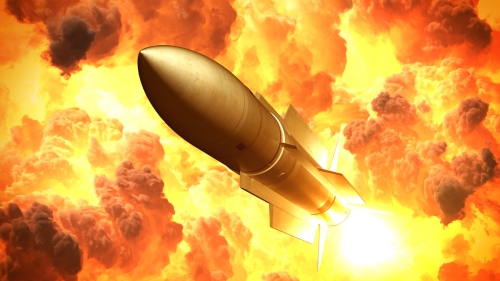Disarmament, Not Low-Yield Nukes

Seven-plus decades ago, as humanity was ensnarled in a monstrous world war, its instinct to win — to dominate others above all else — achieved ultimate manifestation: the capacity to annihilate all life on Planet Earth.
Nuclear weapons are, you might say, the logical outcome of the 10,000-year journey of civilization: “God blessed them and said to them, ‘Be fruitful and multiply, and fill the earth and subdue it; rule over the fish of the sea and the birds of the air and every creature that crawls upon the earth.’”
And so we have. And now we’re stuck with ourselves, as are all other forms of life.
When the issue is nukes, and what to do with them, I think the first mistake we make is to put them into too narrow of a context, within which they seem “necessary” (because others have them) and “usable” (just in case, you know, a really evil country or terrorist organization starts threatening us) and there’s no larger sense of how to be alive and what survival actually means.
In the us-vs.-them consciousness of nationalism — the cage in which most U.S. political and opinion leaders are trapped — there could hardly be a concept more worthy of eyeball-rolling contempt than disarmament.
And once nuclear disarmament is deemed out of the question, or “unrealistic,” the nuclear playing field remains wide open. Thus, among other fragments of incendiary news from the Trump administration, there’s this: “The U.S. Department of Energy has started making a new, low-yield nuclear weapon designed to counter Russia,” as NPR reported a few days ago. The weapon, known as the W76-2, would also, I fear, free the generals and war planners from the straightjacket known as Mutually Assured Destruction, or MAD, that cruel paradox of national defense: that possession of humanity’s most powerful weapon doesn’t mean you can use it. Nukes have no purpose other than to prevent their use by others who possess them.
Mutually Assured Destruction, a.k.a. mutual vulnerability, has been the ruling principle of a nation-divided planet for the entirety of my lifetime. It’s a sophisticated advancement beyond mere conquest, which was the ruling principle of empire. MAD represents an acknowledgement, of sorts, that our instinct to conquer has a limit. We still want to dominate each other, and playing conventional war, especially against impoverished and indigenous peoples, and exploiting their resources, is still permissible, but the development of nuclear weapons is humanity’s apex. We can have them but we can’t use them.
It’s a way of sort of getting along, and it’s a cornerstone of political centrism. It’s also a brilliant way to marginalize the proponents of disarmament and keep the cash flowing endlessly to the military industrialists of the world. Even though nukes must never be used, we have to keep upgrading our stash.
Robert Dodge of Physicians for Social Responsibility, for instance, writes of “the new arms race initiated by the United States plan to spend over $1 trillion in the next three decades to rebuild our entire nuclear arsenal. This plan has been duplicated by every other nuclear nation, not wanting to fall behind in the mythological idea of ‘nuclear deterrence.’”
Defense Secretary Jim Mattis put it a little more politely: “America can afford survival.”
Mattis (maybe I finally get his nickname, MAD Dog) is quoted by Republican Sen. Jon Kyl and former CIA acting director Michael Morell in a recent Washington Post op-ed, in which they defend the development of low-yield nukes. In the process, they make this fascinating comment:
“As the government’s mind-set shifts from waging counterterrorism and counterinsurgency wars to a return of great power competition with Russia and China, nuclear weapons must continue to maintain their deterrent effect.”
So we’re done with the war on terror now? Does that mean we’ve bombed evil out of existence, or simply that it’s time to abandon our quagmires and move on — or rather, move back, to the good old days of the Cold War?
Russia, they write, “is intent on exploiting what it perceives as a U.S. nuclear capability gap on the lower levels of the escalatory ladder. That is because a high-yield, long-range U.S. response to Russia’s first, limited use of a low-yield nuclear weapon against a military target is not credible. The Russians believe we are not likely to risk a global thermonuclear war in response to a ‘tactical’ nuclear attack by them.”
We’re good, they’re evil, but damn, we need to beef up “the lower levels of the escalatory ladder” so that Russia knows we have the ability to smother them with usable nukes if they toss some at us.
This is how the Consensus talks and thinks and acts, ever on the hair-trigger, which happens to be lucrative in the extreme. Survival means a tough posture and endless military, including nuclear, investment. We’re ruled by our paranoia, by the worst of who we are: by our domination complex.
Two crucial matters play no part in this caged thinking.
One is the ultimate realism of nuclear weapons, as relayed to the world by survivors of the Hiroshima and Nagasaki bombings. I’ve quoted Setsuko Thurlow before. She was a 13-year old schoolgirl when Hiroshima was hit:
“They were naked or tattered, burned, blackened and swollen. Eyes were swollen shut and some had eyeballs hanging out of their sockets. . . . Strips of skin and flesh hung like ribbons from their bones. Often these ghostly figures would collapse in heaps never to rise again. With a few surviving classmates I joined the procession carefully stepping over the dead and dying.
“At the foot of the hill was an army training ground about the size of two football fields. Literally every bit of it was covered with injured and dying who were desperately begging, often in faint whispers, ‘Water, water, please give me water.’ But we had no containers to carry water. We went to a nearby stream to wash the blood and dirt from our bodies. Then we tore off parts of our clothes, soaked them with water and hurried back to hold them to the mouths of the dying who desperately sucked the moisture. . . .”
The second is the fact that, in 2017, most of the world — 122 nations — passed a resolution in the United Nations calling for the elimination of nuclear weapons: “. . .each State Party that owns, possesses or controls nuclear weapons or other nuclear explosive devices shall immediately remove them from operational status and destroy them, as soon as possible.”
For some reason, the debate on the Prohibition of Nuclear Weapons treaty was boycotted by all nine nuclear-armed nations, along with the armed West’s NATO allies. The vote was, of course, instantly forgotten so that disarmament, as a concept, need never be a part of the official discussion of how to achieve deterrence.
*****
Robert Koehler is an award-winning, Chicago-based journalist and nationally syndicated writer. His book, Courage Grows Strong at the Wound is available. Contact him at [email protected] or visit his website at commonwonders.com.
© 2019 TRIBUNE CONTENT AGENCY, INC.

















